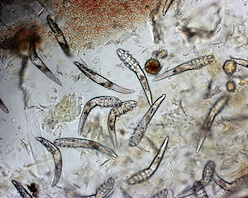How to treat mange in your dog

Our second post from vet Marc Abraham looks at mange: what causes this unpleasant infection, how it affects dogs and what can be done about it
Some common pet diseases can prove notoriously stubborn and expensive to fix, taking weeks or even months to see any improvement.
A classic example is mange - infestation of your pet's skin by tiny mites resulting in hair loss and itching; but not all mites behave in the same way, with individual species of mite bestowing their own unique ill effects on their poor victims.
The two main types of mange mite affecting dogs are sarcoptic (scabies) and demodectic (from the genus Demodex), with others such as ear mites and seasonal harvest mites usually causing less severe problems.
Sarcoptic mange is caused by a highly contagious mite spending its whole life cycle burrowed in the outer layers of skin, giving rise to intense itching, which quickly leads to raw, painful lesions caused by self-inflicted scratching and chewing - especially at the ear flaps and elbows.
Scabies is the mange we can catch from dogs by direct contact and is also spread via grooming and infected bedding. Foxes are significant sources of sarcoptic mange too, with recent rises in urban fox populations often blamed for nasty outbreaks.
Unlike sarcoptic mange, demodectic mange behaves very differently, living within the hair follicles of your dog and very rarely spreading to us or other dogs (apart from during a dog's first few days of life, transferring from mum to pup via the muzzle).
 Some Demodex mites isolated from a Shar Pei (image courtesy of Dr Michael Dryden, Kansas State University)
Some Demodex mites isolated from a Shar Pei (image courtesy of Dr Michael Dryden, Kansas State University)
Dogs with healthy immune systems rarely succumb to Demodex, as they quickly and efficiently contain the parasite, preventing multiplication and disease. However, the minority of dogs with much weaker defence systems aren't able to beat these mites, so lesions develop and disease spreads locally to the face and forelimbs or more widely across the body.
Cases of Demodex usually resolve when the dog's immune system kicks in at about a year old. But without immune control, disease can become very generalised and even life-threatening, with characteristic hair loss, skin reddening and severe secondary bacterial infections.
Most mite infestations can be diagnosed by direct identification under the microscope (pictured) after skin scrapes or hair plucks. However, these don't always reveal the offending creatures, so it's not uncommon for your vet to start treatment before any positive ID.
These days, new drugs, anti-parasitic shampoos, dips and spot-on treatments usually mean quicker response times, but multiple treatments taking up to six months are often necessary. As with all diseases, the quicker you visit your vet, the more likely mange can be dealt with effectively.
Marc Abraham is a TV vet who regularly gives the nation pet advice on This Morning, BBC Breakfast and Daybreak. As well as promoting responsible pet ownership, rescue pet adoption, microchipping and responsible dog breeding, Marc is also an active campaigner against the puppy farming industry and is the founder of Pup Aid. Marc has also written the books Vet on Call and Pets in Need and also has the Canine Care iPhone app for dog owners. For more about Marc, visit www.marcthevet.com or follow him on X @marcthevet

